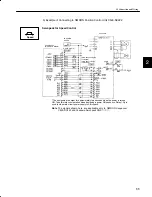
2.4
Conducting a Test Run
37
2.4
Conducting a Test Run
This section describes how to conduct a full test run. The test run is divided into two
steps. Complete a test run in step 1 first, then proceed to step 2.
2.4.1
Test Run in Two Steps
37
. . . . . . . . . . . . . . . . . . . . . . . . . . . . . . . . . . . . . . . . . . . .
2.4.2
Step 1: Conducting a Test Run for Motor without Load
39
. . . . . . . . . . . . . . . .
2.4.3
Step 2: Conducting a Test Run with the Motor Connected to the Machine
43
2.4.4
Supplementary Information on Test Run
45
. . . . . . . . . . . . . . . . . . . . . . . . . . . .
2.4.5
Minimum User Constants Required and Input Signals
47
. . . . . . . . . . . . . . . . .
2.4.1 Test Run in Two Steps
Conduct the test run when wiring is complete.
Generally, conducting a test run for servo drives can be difficult. However, by following the two
steps described below, the test run can be performed safely and correctly.
NOTE
To prevent accidents, initially conduct a test run only for a servomotor under no load (i.e., with
all couplings and belts disconnected). Do not run the servomotor while it is connected to a
machine.
The test run is divided here into steps 1 and 2.
Complete the test run in step 1 first, then proceed to step 2. The purposes of each step are
described on the next page.
2
















































